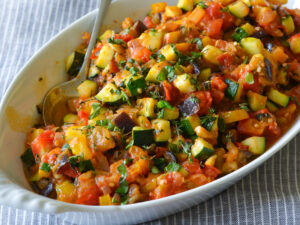Ratatouille is a traditional Provençal vegetable stew that is not only delicious but also offers a variety of nutritional benefits.
This Mediterranean dish is made from a combination of colorful vegetables and herbs, typically including eggplant, zucchini, bell peppers, onions, garlic, and tomatoes.
Nutritional benefits of Ratatouille
1. Rich in Vitamins and Minerals:
- Vitamin C: Bell peppers and tomatoes are excellent sources of vitamin C, which is essential for immune health, collagen production, and skin health.
- Vitamin A: Tomatoes and bell peppers are also rich in vitamin A, which is important for vision, skin health, and immune function.
- Folate: Eggplant and bell peppers provide folate, a B-vitamin important for cell division and DNA synthesis.
- Potassium: Zucchini is a good source of potassium, which helps regulate blood pressure and maintain proper muscle and nerve function.
- Manganese: Eggplant and zucchini contain manganese, a mineral that plays a role in bone formation and metabolism.
2. Dietary Fiber:
Ratatouille is high in dietary fiber, thanks to its vegetable-based ingredients. Fiber has several health benefits, including:
- Digestive Health: Fiber promotes regular bowel movements and can help prevent constipation.
- Weight Management: Foods high in fiber can help you feel full and satisfied, which can aid in weight management.
- Blood Sugar Control: Fiber can slow the absorption of sugar, helping to stabilize blood sugar levels.
- Heart Health: A high-fiber diet can help lower cholesterol levels and reduce the risk of heart disease.
3. Antioxidants:
The colorful vegetables in ratatouille are rich in antioxidants, which help protect the body from free radical damage and oxidative stress. Antioxidants are associated with various health benefits, including reduced risk of chronic diseases such as heart disease and certain cancers.
4. Low in Calories:
Ratatouille is a low-calorie dish, making it a healthy option for those looking to manage their calorie intake. It can be a satisfying addition to a weight-conscious or calorie-controlled diet.
5. Suitable for Different Diets:
Ratatouille is naturally vegetarian and vegan, making it suitable for individuals following these diets. It’s also gluten-free, which is beneficial for those with gluten sensitivities or celiac disease.
6. Versatile and Nutrient-Dense:
Ratatouille can be enjoyed on its own as a side dish, served over pasta or rice, or even as a topping for grilled bread or pizza. Its versatility makes it easy to incorporate into various meals, allowing you to benefit from its nutritional value in different ways.

Ingredients
- 1 large eggplant
- 2 medium zucchinis
- 2 bell peppers (red and yellow or green)
- 2 medium tomatoes
- 1 large onion
- 3-4 cloves garlic, minced
- 2-3 tablespoons olive oil
- 1 can (14 ounces) crushed tomatoes (or 2-3 fresh tomatoes, peeled and diced)
- 1 teaspoon dried thyme
- 1 teaspoon dried rosemary
- 1 bay leaf
- Salt and black pepper to taste
- Fresh basil leaves, for garnish (optional)
Instructions
- Prepare the Vegetables:
- Wash and dry all the vegetables.
- Cut the eggplant, zucchinis, and bell peppers into small, roughly equal-sized cubes.
- Peel and dice the onion.
- Cut the fresh tomatoes into chunks or use canned crushed tomatoes.
- Sauté the Vegetables:
- In a large skillet or pot, heat the olive oil over medium heat.
- Add the diced onion and minced garlic. Sauté for a few minutes until the onion becomes translucent and fragrant.
- Add the Eggplant:
- Add the cubed eggplant to the pot. Stir to combine with the onions and garlic.
- Cook for about 5 minutes, stirring occasionally, until the eggplant begins to soften.
- Add the Zucchini and Bell Peppers:
- Add the cubed zucchinis and bell peppers to the pot with the eggplant.
- Continue to cook for another 5-7 minutes, or until all the vegetables have softened slightly.
- Incorporate Tomatoes and Seasonings:
- Add the crushed tomatoes (or fresh tomatoes), dried thyme, dried rosemary, bay leaf, salt, and black pepper to the pot.
- Stir well to combine all the ingredients.
- Simmer and Cook:
- Reduce the heat to low and cover the pot.
- Allow the Ratatouille to simmer gently for about 20-25 minutes, or until all the vegetables are tender and the flavors have melded together. Stir occasionally.
- Taste and Adjust Seasoning:
- Taste the Ratatouille and adjust the salt and pepper to your preference. Remove the bay leaf.
- Serve:
- Ratatouille can be served warm, at room temperature, or even chilled. It’s traditionally garnished with fresh basil leaves, which add a delightful aroma and flavor. Drizzle with a little extra olive oil before serving if desired.
Clearly, it’s worth noting that the nutritional content of ratatouille can vary depending on the specific ingredients used and the cooking methods. For example, using olive oil in the preparation can add healthy monounsaturated fats to the dish, which can be beneficial for heart health.
Overall, ratatouille is a delicious and nutritious dish that provides a colorful array of vegetables and a range of vitamins, minerals, and antioxidants. It can be a valuable addition to a balanced and health-conscious diet.










